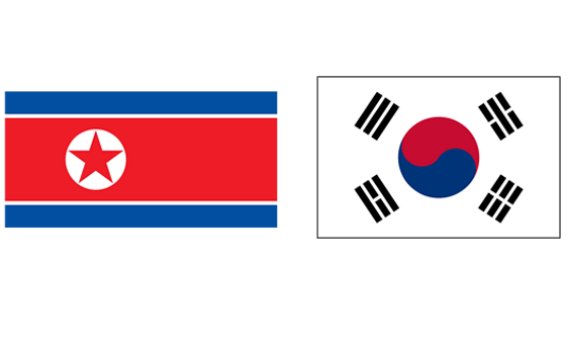Check this one off your bingo card: The London Games has had its first foreign relations gaffe. North Korea’s women’s soccer team initially refused to take the field for its match against Colombia after the scoreboard showed the South Korean flag beside the North Korean players’ faces. The game eventually began 65 minutes after its scheduled start time. The stadium’s media manager has apologized.
You could see how the scoreboard operator might make this mistake, as the two countries’ flags look … OK, honestly, they look nothing alike. But these things happen—in 1992, the Estonian flag flew upside down during that country’s first ever medal ceremony.
Today’s Korea mix-up does offer an opportunity to examine how these national symbols represent the countries’ very different ways of life. The South Korean flag—seen above on the right—was first adopted in 1883 and represented both territories before the countries’ mid-20th-century split. The modern version has three parts, all freighted with symbolism. The white background signifies cleanliness and peace. A red-and-blue taegeuk symbol in the center symbolizes the balance of um and yang. Four black trigrams represent four universal elements: heaven, earth, fire, and water.
North Korea adopted its flag in 1948 when the country formally declared its independence and represents the country’s revolutionary socialist beginnings. The flag of the Democratic Public of Korea does share a color scheme with that of its southern neighbor. It is composed of two horizontal blue stripes framing a red stripe, said to represent the country’s revolutionary spirit. In the middle is a white disk overlaid with a red star, a common symbol of socialism.
If this screw-up had happened six years ago, the mistake may not have made such a stir. In the 2000, 2004, and 2006 Olympics the two countries joined together at the games’ opening ceremonies and marched in matching uniforms behind the Korean Unification Flag. (The two countries did still officially participate as separate teams.) In the 2008 Beijing Olympics, however, the countries refused to march together, a move International Olympic Committee President Jacques Rogge called a “setback for peace.” There have also been no talks of marching together in 2012, and the umbrage taken by the North Korean team today draws attention to the countries’ recent wobbly relations.
On the field, the North Koreans eventually won their match against Colombia 2-0. We wish them a mistake-free tournament going forward, with no flag-related errors and no players struck by lightning.
